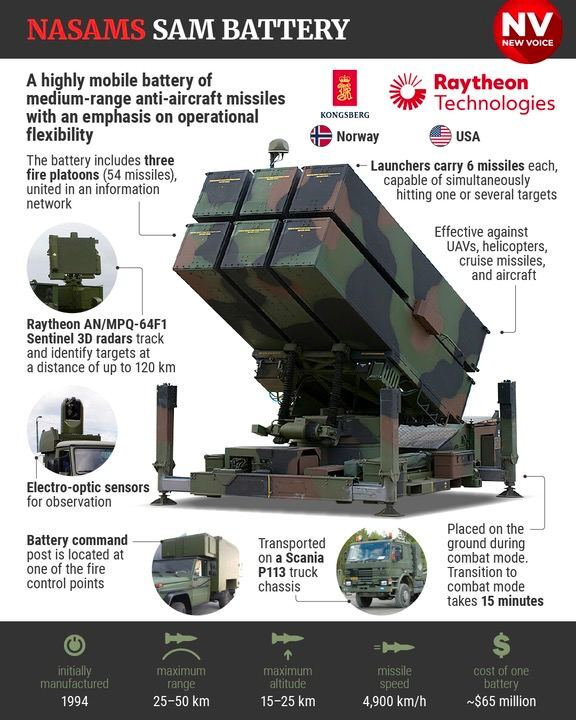Why Western military manufacturing has fallen behind Russia and China

Russia's vicious war against Ukraine significantly increased the global demand for Western weapons systems, in particular anti-aircraft missile systems, while authoritarian regimes such as Russia and China have been able to outpace them in production, as the Wall Street Journal has explained in an elaborate report on Jan 5.
"The Ukraine war has highlighted the West’s deficiencies in quickly producing more weapons at a time of need…The constraint is particularly acute for missiles and the systems that defend against them, and also guard against the swarms of drones that have become a central element of modern warfare,” the publication says.
Read also: White House finds no evidence of widespread corruption or misuse of US-supplied weapons in Ukraine
NV is recapping the report’s most important excerpts.
Everyone wants NASAMS: why these air defense systems are in short supply
To demonstrate how slowly modern Western weapons are made, WSJ reporters visited the Kongsberg Defense & Aerospace plant in Norway, which manufactures NASAMS anti-aircraft missile systems. This system is capable of shooting down drones, helicopters, missiles, and other air targets from a distance of about 30 km.
In Ukraine, NASAMS was deployed for the first time in 2022. At the same time, Ukraine noted its extraordinary effectiveness and 100% interception rate, in particular for cruise missiles and drones.
Read also: Western weapon already helps Ukrainian troops, but there’s never enough during war
Now that the West is facing more and more potential threats, including Russia and China, the Norwegian company has received a flurry of orders.
"I've never seen this much demand," says Eric Lee, president of Kongsberg Defense & Aerospace, who has been with the company for 30 years.
However, new customers will have to wait: it takes two years to make one NASAMS complex, and there is already a multi-year backlog in fulfilling orders, writes the WSJ.
To ramp up production, Kongsberg's facilities, which also make ship-launched missiles and parts for F-35 fighter jets, switched to working 24 hours a day, seven days a week, and are now open even on some holidays, when the plant would normally be closed. However, even this may not be enough.
The problem is that modern weapons are extraordinarily complex and often require thousands of parts, explains the WSJ. Like most Western defense companies, Norway's Kongsberg designs and assembles its weapons systems, but does not manufacture most of their components. More than 1,500 suppliers deliver products to this plant. The NASAMS supply chain alone consists of more than 1,000 companies and is spread across two continents — Norway and the United States, where the American defense contractor RTX (formerly Raytheon Technologies) produces components for NASAMS radars and missiles.
"Our suppliers are companies with their own supply chains, which in turn have their own supply chains, and they have their own supply chains, all the way to the mine where the necessary resources are extracted," explains Lee.
The WSJ adds that in the 1980s, Kongsberg made its own computer hardware for its weapons; whereas now the company buys it ready-made. Also, about 15 years ago, the 200-year-old company was welding parts itself, but currently outsources this process.
Now, only when all the components are ready is the Norwegian manufacturer able to assemble the NASAMS mobile command center–the complex decision-making center that is the "brain" of the system – over the course of a month.
To protect itself against supply chain disruption risks, Kongsberg has stockpiled key components and keeps spare NASAMS to ship to customers when needed quickly.
In addition, the company is trying to find alternative suppliers for as many components as possible to have options if one of its supply chain links "falls out." In June 2024, Kongsberg will open a new factory using a more efficient assembly line. The company expects this method to increase rocket production by a factor of 10.

Missiles for just one week of war: What else is missing in the West
The extraordinary demand for NASAMS air defense systems is just one example of the shortage of weapons that Western countries are currently experiencing.
Despite increasing defense budgets, the West now faces its most significant deficit since the Korean War, according to military analysts cited by the WSJ. The top ten Western defense companies alone now have orders worth more than $730 billion, about 57% more than at the end of 2017, when demand started to pick up.
Read also: US should give Ukraine weapons to ‘actually win’ — Mike Pompeo
Senior US and NATO officials are increasingly worried about the risk that a shortage of weapons could affect the combat effectiveness of their armies.
According to the results of wargaming conducted by the Center for Strategic and International Studies released at the beginning of 2023, the US risks exhausting its stockpile of long-range anti-ship missiles within the first week of a hypothetical Chinese invasion of Taiwan.
At the same time, the US will only be able to replenish its reserves slowly: as in the case of NASAMS, producing each such missile takes about two years.
Similar problems are possible for other categories of missiles. The American companies Lockheed Martin and RTX said in 2023 that it would take four years to double the production of surface-to-air missiles such as the Javelin and Stinger. This is twice as long as previously expected. Supply chains are a problem, with both solid rocket motors and chips in short supply, as well as simpler components such as springs and ball bearings.
The Pentagon tried to examine the global supply chains for Javelin and Stinger production to find workarounds for the "bottlenecks," but concluded that there was no such possibility, writes the WSJ.
There are also significant delays in the delivery of other weapons, including F-35 fighter jets, new training and refueling aircraft, as well as the newest US aircraft carriers.
What limits the capabilities in the production of weapons
The WSJ article lays out several reasons for the inability of the Western defense industry to meet the current demand for weapons. Among them are the following:
– Reductions in defense budgets after the Cold War and gradual deindustrialization, especially in Europe: While German companies could produce up to 400 tanks per year at the height of the Cold War, they can now build no more than 50 annually.
Read also: Russia can produce and repair 100-150 tanks per month – Latvian Defense Ministry
– Labor shortages: High-tech Western industries require workers with specialized skills, from software development to welding, while being able to pass lengthy security checks.
– The complexity and high cost of modern weapons: newer arms take longer and cost more to produce, which limits supplies and lengthens the time needed to replace weapons. Modern missiles are like mini-fighters with their own sophisticated electronics and guidance systems, Charles Woodburn, chief executive of the British defense company BAE Systems, explained to the WSJ.
However, the need for missiles [in particular anti-aircraft missiles] has only increased in recent years, in particular, due to the prevalence of such new threats as drones and the development of hypersonic weapons.
Opposition to authoritarian regimes with state production: "Russia and China have overtaken the United States and Europe in some missile and defense systems," states the WSJ.
According to the International Institute for Strategic Studies, Russia and China together have about 5,020 ground-based air defense missile systems. At the same time, the United States, Europe, and Japan combined have only 3,200 (the report did not assess quality and did not count small arms and sea-based systems).
Read also: First batch of 122mm munitions produced in partnership with European partners arrives in Ukraine
The Pentagon admits that the Russian Federation and the People's Republic of China already have hypersonic missiles, while in the United States, they should be fully operational only in 2024. In addition, the latest American and European defense systems against hypersonic missiles will not enter service for at least another ten years, the article says.
The authors of the article explain that defense companies in China and Russia are primarily state-owned, so they are subject to less commercial pressure than in the West. China's vast manufacturing sector also means the country can rely on a large domestic supply chain and many in-house professionals whose education meets industry needs.
According to analysts cited by the WSJ, China's stockpile has grown from a small number of non-nuclear ballistic missiles in 1996 to an assessed 3,000+ ballistic and cruise missiles today.
At the same time, the Pentagon believes that most of China's missile systems are comparable in quality to the weapons of other "higher-level" global manufacturers and that the country has one of the world's largest networks of advanced long-range missile systems.
Russia, according to Ukrainian intelligence, is capable of producing about 100 cruise missiles of two different types every month, as well as up to four Kinzhal hypersonic ballistic missiles and up to five ballistic missiles. In addition, Russia is likely receiving missiles, rocket launchers, and projectiles from North Korea, which supports its ability to wage war against Ukraine.
The impact of Russia’s war against Ukraine on the missile weapon market
Ukrainian President Volodymyr Zelenskyy constantly emphasizes that Ukraine’s most significant current need is anti-missile defense systems. However, the West currently does not have large enough reserves of such systems to share them. Moreover, missile defense and air defense are being requested by both Ukraine and Israel, the article says.
Read also: Russia made one of the Kh-101 missiles downed over Kyiv in late 2023 — Defense Express
According to Pentagon officials, Washington's support for two allies involved in major conflicts at once further reduces its ability to supply such weapons, increasing demand for some systems, including artillery shells and anti-missile defenses.
Back in the fall of 2023, Zelenskyy said that the war in the Gaza Strip had already slowed down the supply of artillery shells to Ukraine.
At the same time, Eric Lee from Norway’s Kongsberg Defense & Aerospace notes that the increase in demand for NASAMS systems began even after Russia annexed Crimea in 2014. Orders for these missile systems then skyrocketed after the full-scale invasion of Ukraine in February 2022. Concerns about possible expansion from China are also starting to show, with the US Navy and other customers ordering ship-based missiles.
Kongsberg's defense order log now stands at about $5.5 billion, roughly six times its pre-2018 level.
The WSJ says that in late 2022, the US ordered six more NASAMS for Ukraine, the first of which began to arrive in Ukraine in the summer of 2023. Meanwhile, five other countries, including Taiwan, have expressed interest in buying the system.
At the same time, Asian countries, faced with growing tensions in relations with China and shortages in the West, are now trying to develop their own missile capabilities, in particular, due to the limited production of such weapons in the United States. The WSJ writes that in 2022, Taiwanese officials even complained about delays in the delivery of American Stinger anti-aircraft missiles, hinting that the supply of such missiles to Ukraine was behind the problem. Similar "alarming delays" occurred with anti-ship missiles for Taiwan. They were ordered in 2019, and the first batch arrived only in the spring of 2023, the article says.
So from 2021, Taiwan began mass production of its own new long-range land-based missile, and the country is developing three more types of long-range missiles, Taiwanese officials say.
Most Western defense companies are also trying to increase their capacity to produce projectiles and missiles. The Pentagon soon plans to implement a new industrial strategy that will help eliminate supply chain problems.
We’re bringing the voice of Ukraine to the world. Support us with a one-time donation, or become a Patron!
Read the original article on The New Voice of Ukraine

